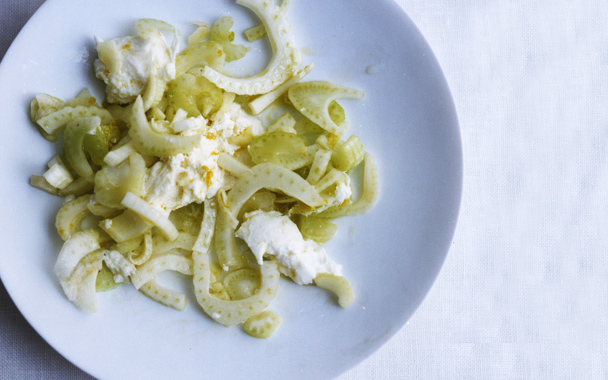I first became a fan of Ursula Ferrigno when I was working for a British publishing company. A colleague told me I’d love her books and that she was, as the Brits say, “spot on.” Each and every one of Ferrigno’s cookbooks is a joy. On trips to London, I’d always make a point to scour the Notting Hill shop Books for Cooks for any new Ferrigno titles.
I pitched the idea of having Ferrigno do a menu for Gourmet, lending Ruth Reichl my precious cookbooks for support, and I couldn’t have been more thrilled when she gave it the go-ahead. Ferrigno’s honest, thoughtful food had won her over, too.
Before I had the chance to meet Ferrigno face to face, we corresponded about the menu. One of Ferrigno’s recipes was to be a Dama Bianca, translated as Woman in White—an Italian fennel and celery salad with bits of mozzarella. Though I knew Ferrigno had a sort of quirky style, I had to read twice when I came upon this sentence in her email: “When shopping for the two fennel bulbs, one should choose one male and one female bulb for balance.” This was the first I’d ever heard about fennel bulb gender. I had to give her a call right away for clarification. Ferrigno explained that the male bulbs were long and slim whereas the female bulbs were bulbous—or as she put it, they “had hips.” Okay, that was how you were to tell them apart, but why one of each? The male fennel, apparently, has a stronger flavor, while the female has a more fibrous texture. Combining them, according to tradition, results in the perfect marriage.
So I did what anybody would do. I googled it. And yes, there were plenty of discussions on male and female fennel. It’s even reached The New York Times, who referenced Marcella Hazan on the topic—yet, interestingly, Hazan suggests it’s the other way around: that the slender bulbs are the females. As much as I adore Hazan’s cooking, life experience suggests that slender males and broad-hipped females is the obvious distinction.
Shooting the story with Ferrigno in London at Cucina Caldesi, the Italian cooking school, where she is a teacher, I finally ate the salad as she prepared it. I’m not sure I could taste the melding of the male and female fennel, but it was just right, so I have to acknowledge that a little old-world wisdom might very well be the secret ingredient. To this day, I haven’t figured out if fennel bulb gender is fact or folklore—but I love it, and now I always make sure to sex my fennel.
Don't forget to seek out male and female fennel when making our refreshing salad.




 Pinterest
Pinterest


